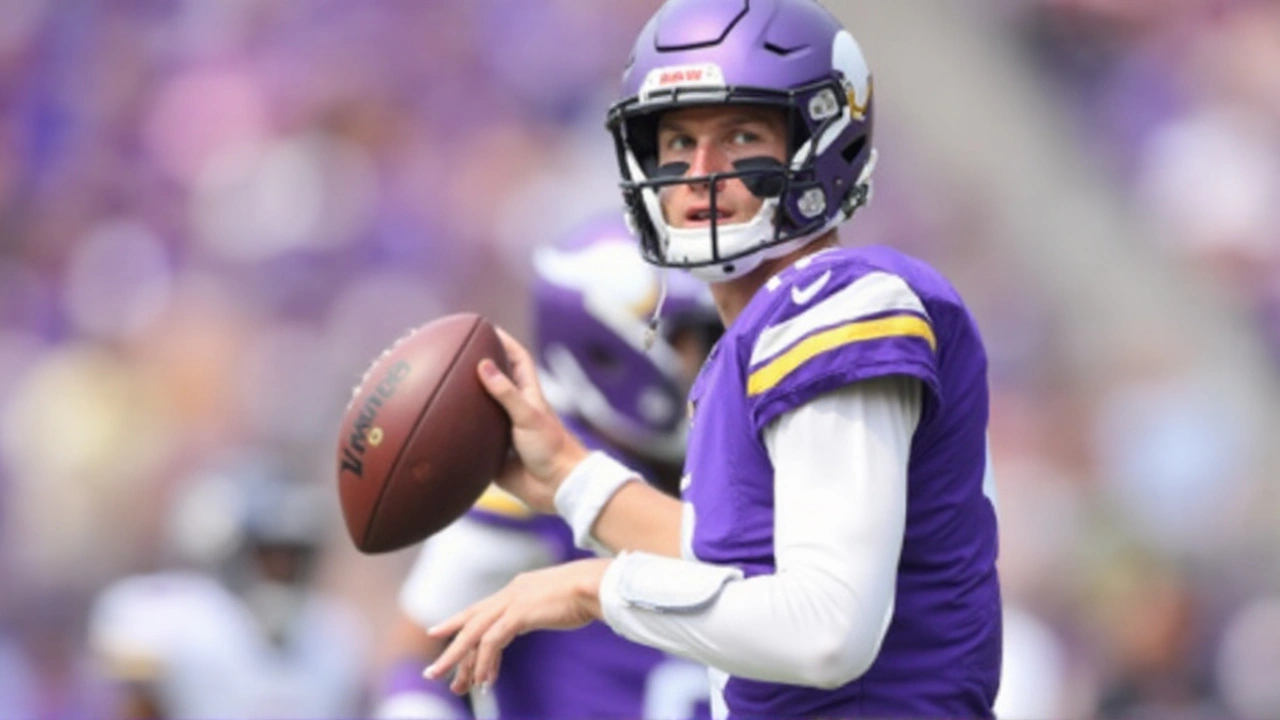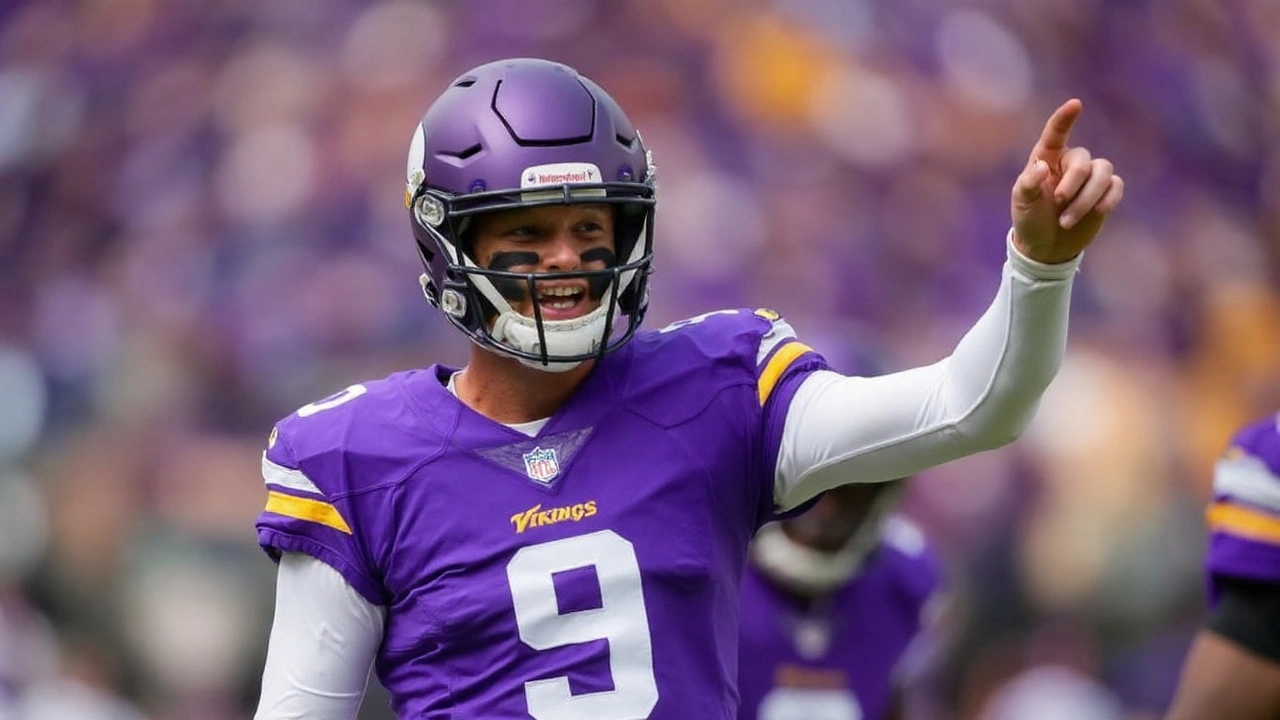A rare debut, a captain’s message, and a high-stakes handoff
The Minnesota Vikings are doing something you almost never see after a 14-3 season: they’re turning the offense over to a first-time starter. For J.J. McCarthy, Monday night against the Chicago Bears isn’t just a debut. It’s a reboot. He’s the first first-round quarterback in the modern era to miss his entire rookie year with an injury, sidelined by a torn meniscus in his right knee. Now he walks into a playoff-caliber locker room with real expectations and a spotlight that doesn’t blink.
Justin Jefferson, speaking before kickoff on behalf of Sleep Number, didn’t give him a playbook speech. He gave him a human one. “It’s just all about having confidence in yourself,” Jefferson said. “Remember the things we went over in practice… let that little kid out and let him go play.” That’s not fluff. That’s the core of how quarterbacks survive on night one: trust your prep, trust your eyes, and don’t play scared.
The Vikings’ timeline makes this night even bigger. Sam Darnold’s 2024 run in Minnesota was a clear breakthrough, the roster won big, and the window looked open. Yet the plan never changed after the franchise spent the 10th overall pick on McCarthy. Minnesota didn’t chase a high-priced veteran replacement this offseason. They made only a small trade for Sam Howell, kept their draft capital focused on the rest of the roster, and built a structure designed for a young quarterback to grow without being crushed by weight he can’t carry yet.
Jefferson has taken on the job of steadying that process. He’s McCarthy’s captain and his closest neighbor in the building — literally. “Our lockers are right next to each other,” Jefferson said. “Every chance I get to talk to him about football, about anything that goes on outside of football… when we’re locked in, I want him to be just as confident as I am of him to make the plays out there.” That day-to-day stuff matters more than highlight clips. It’s how trust gets built when you lose a year to rehab and meetings instead of live reps.
Put simply: Minnesota is betting on ceiling and timing. A first-round quarterback on a rookie deal lets you spend on protection, pass rush, and weapons. That’s how you keep pace in a conference stacked with elite offenses. It’s also why this handoff feels bold but logical. You draft a quarterback in the top 10 because you expect him to define your next five years, not sit there in case of emergency.
McCarthy does show up with big-game mileage. He steered Michigan through a title run, played inside structure, and avoided the panic throws that bury young passers. College isn’t Sunday night in the NFC North, though. The windows shrink, the pass rush is faster, and disguised looks don’t announce themselves. Jefferson knows it. “Last year pretty much doesn’t count for him,” he said. “He’s still new to the scheme, new to coming out here and throwing it to these different receivers.” Translation: use what you know, but be ready to learn in real time.
The Bears under Matt Eberflus will challenge that patience. You’ll see zone looks that rotate late, coverage shells that bait the first read, and bodies flashing into passing lanes you thought were open. For a quarterback with limited NFL tape, the defense will test whether he can work from one to two to three without drifting into trouble.
So what does success look like in a debut like this? It often isn’t fireworks. It’s control. It’s hitting the throws the system gives you, keeping the ball out of harm’s way, and getting the huddle in and out clean. That sets the table for Jefferson and the rest of the skill group to win the hard parts — contested catches, yards after the catch, and third-down conversions.

How the Vikings set the table for a young QB
Head coach Kevin O’Connell’s offense is built to help a quarterback breathe. Think motion before the snap, condensed formations that create traffic for defenders, and play-action that turns linebackers into guessers. The reads are layered and clear: a shot if it’s there, an intermediate crosser if it’s not, a back in the flat if the front is screaming at you. You don’t have to be a superhero. You have to be on time.
The Vikings also spent the last year fixing things around the position. They invested in the offensive line and reinforced the front seven, the kind of moves that don’t light up social media but win in November and December. Better protection turns deep drops from a risk into a tool. A sturdier defense means fewer games where your quarterback has to throw 45 times just to keep up.
Jefferson’s presence changes the math on every down. He moves corners, he tilts coverage, and he forces safety help that frees up space for everyone else. That’s where the chemistry with McCarthy has to show up fast. Accurate timing throws to Jefferson set up in-breakers for Jordan Addison and underneath windows for the backs and tight ends. When the ball is out on time, the YAC comes with it.
McCarthy’s Michigan tape points to a style that fits this setup. He can work from under center and shotgun, he’s comfortable on boots and keepers, and he doesn’t need to force throws into bracket coverage to feel involved. When the call sheet leans on play-action, he’s at home. When the defense sits in soft zones, he’ll take the singles and wait for the double. That’s how you win with an elite receiver without asking your quarterback to be reckless.
Inside the building, the message to a first-time starter is usually simple and repetitive. Be decisive. Protect the ball. Use your legs to buy time, not to play hero. O’Connell’s structure reinforces that. Many of the early calls will likely be clean reads: quick game to get him in rhythm, movement passes to cut the field in half, and a few shots off hard run looks when the Bears start nosing forward.
Jefferson’s advice threads through that plan. Confidence isn’t a speech; it’s a product of preparation. He told McCarthy to “remember the things that you have installed in your brain throughout this entire process of getting to this moment.” That’s years of footwork, protections, hots, and sight adjustments — not Instagram highlights. If he trusts that library, the ball comes out on time and the game slows down.
There’s also a practical reason the Vikings didn’t add a big-name insurance policy this offseason. Reps matter. When you’re developing a quarterback, the cleanest path is clear hierarchy: QB1 gets the lion’s share of first-team work, sees the defense’s main looks in practice, and builds day-to-day timing with the starters. A crowded depth chart often muddies that. Minnesota chose clarity.
The shift from Sam Darnold, after a season that earned respect in the locker room, tells you how committed the Vikings are to the long view. It’s not a knock on Darnold; it’s a belief that the team’s best chance at sustained contention is tying Jefferson’s prime to a young quarterback who can grow into the job while the roster stays strong around him. That’s the same logic Kansas City used moving from Alex Smith to Patrick Mahomes after a playoff year: hard choice, higher ceiling.
So what should you expect to see early against Chicago? Likely a set menu of high-percentage concepts, sprinkled with a few deep shots if coverage favors them:
- Quick-game throws to Jefferson on slants, hitches, and glance routes to punish off coverage.
- Play-action crossers and over routes to stress Chicago’s second level.
- Bootlegs and sprints to define the read and cut the field in half.
- Running back checkdowns if linebackers bail and edges push too far upfield.
- One or two schemed verticals if the Bears start jumping underneath routes.
On third down, the key is discipline. Chicago’s defense wants you to get impatient. That’s when interceptions happen — late across the middle, forced throws to the sideline, or hot reads thrown blind under pressure. If McCarthy sticks to the coaching point — live for second and medium, punt if you have to — the game will come to him.
The other lever is tempo. O’Connell can use hurry-up in pockets to simplify defensive looks and let McCarthy play point guard. It doesn’t have to be a two-minute drill. A few snaps of controlled tempo can keep the defense vanilla and help a young quarterback see it, call it, throw it.
Minnesota’s defense has a role in this, too. Short fields change everything for a quarterback making his first start. If the pass rush creates a turnover or the coverage unit steals a possession, the call sheet gets wider. That’s when you can take your shot to Jefferson and force the Bears to back off.
How will we know if the night is trending the right way? Look for these tells: the ball is out on time; the Vikings win on first down; the sacks are coverage sacks, not free runners; and the offense avoids the one back-breaking turnover that flips momentum. If those boxes get checked, the stat line doesn’t have to be flashy to be effective.
None of this erases the nerves. Almost every first start comes with a jittery series or two — a missed layup, an overthrown corner route, a late check at the line. That’s where Jefferson’s counsel lands. “Carry yourself with confidence and understand that you’re here for a reason,” he told McCarthy. “You have the talent to go out there and be who knows, the best ever.” Night one isn’t about the “best ever.” It’s about the next throw. Stack enough of those, and you’re in the right huddle for a long time.
For the Vikings, the calculation is clear. They believe the surrounding cast, the scheme, and the defense will help their young quarterback handle the learning curve fast. They believe the relationship between their captain and their new starter can bridge the gap that an injury year created. And they believe the upside is worth the awkwardness of changing course after 14 wins.
That’s the bet on Monday night. The ball’s in McCarthy’s hands now. The mission is simple: make the easy plays, protect the hard ones, and let your best player tilt the field for you. The long game starts with the first snap.

Written by Xander Whittaker
View all posts by: Xander Whittaker